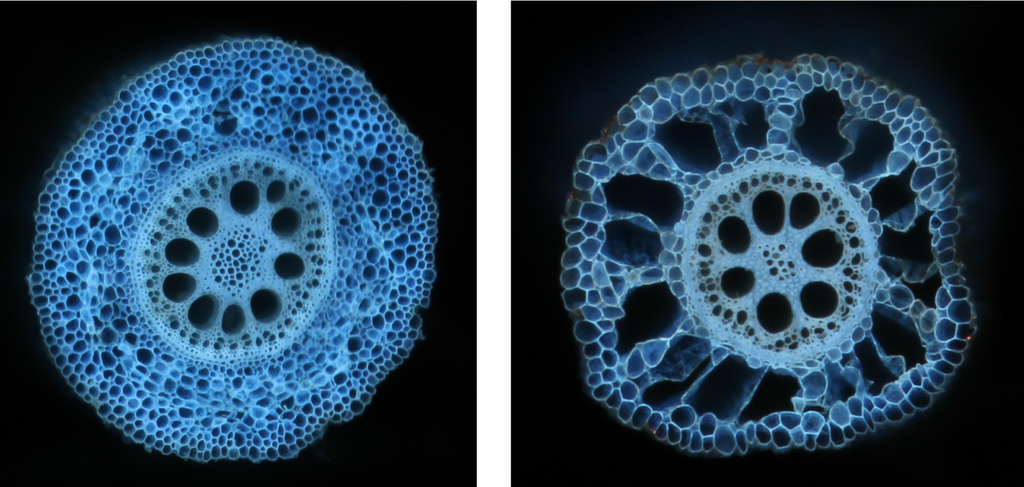Root cortical aerenchyma was assessed for physiological utility in maize, and was found to promote root growth and increase stress tolerance.
Background
Root Cortical Aerenchyma (RCA) is tissue with large intercellular spaces in root cortex [1]. Although vast majority of research on RCA has focused on its importance in hypoxia [2]. RCA can also form in response to drought and edaphic stresses such as nitrogen, phosphorus (P), and sulfur deficiencies [3-6]. RCA is an important adaptation to soil flooding by facilitating oxygen movement to the roots. We hypothesized that RCA is also an adaptation to low nutrient availability by reducing the metabolic cost of soil exploration. By replacing living cells with air, RCA significantly reduces both the respiratory requirement and the nutrient requirement of root tissue, permitting greater root growth and nutrient acquisition for a given metabolic investment.

Fig. 1 Root cross-sectional images from laser ablation technique showing genotypic difference in root cortical aerenchyma formation (Saengwilai 2013).
Hypotheses
Our research supports our hypothesis that RCA is a useful adaptation to low nutrient availability. In bean and maize, we observed large genetic variation in RCA (Figure 1) [7]. Differences in RCA were correlated with proportionate reductions in root P concentration, and greater than expected reductions in root respiration (Figure 2). Root segments with 20% cross sectional area as RCA had only half the respiration of roots without RCA. The disproportionate effect of RCA on respiration may reflect the fact that the cortical cells lost during the formation of RCA are metabolically active, while inactive tissues such as xylem vessels, which are not lost in the formation of RCA, do not respire. Results with isolated root segments were confirmed in intact plants5. These results were supported by a field study, in which RCA was closely correlated with the ability of maize genotypes to maintain root growth under P stress [8].

Fig. 2. Disproportionate reduction of maize root respiration by aerenchyma formation (Fan et al., 2003).
Results from the functional-structural plant model SimRoot showed that RCA formation could be an adaptive response to deficiency of N, P, and K by decreasing the metabolic cost of soil exploration (Figure 3) [9]. By reducing root respiration, RCA decreases the carbon cost of soil exploration, and by decreasing the N and P content of root tissue, RCA permits internal reallocation of nutrients to growing root tissue, which is particularly beneficial under conditions of low N and P availability 9. Under suboptimal P availability, RCA increased growth of a simulated 40 day-old maize by 70% [10]. In the case of nitrogen, RCA increased the growth of simulated maize plants up to 55% in low N conditions, and plants benefit from RCA more in high N leaching environments than low N leaching environments. In addition, the formation of RCA decreases critical soil nutrient levels, defined as the soil fertility below which growth is reduced, suggesting that cultivars with high RCA may require less fertilizer under non-stressed conditions. These in silico results suggest that RCA has potential utility for improving crop nutrient acquisition in both high- and low-input agroecosystems.

Fig. 3. SimRoot, a functional-structural plant model, shows that RCA improves growth under suboptimal availability of nitrogen (N), phosphorus (P), and potassium (K) and reduced critical fertility levels, defined as the nutrient level below which growth is reduced (Postma and Lynch, 2011).
Key Results
In these sections, we show that the ability of RCA to reduce metabolic costs of soil exploration may contribute to drought tolerance and improved N acquisition in low N soil. (Links will become available following publication of results.)
PDF document, 154.3 KB

